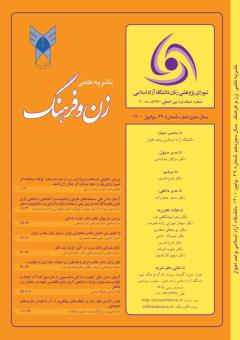بررسی تطبیقی شخصیتپردازی زن در دو داستان کوتاه «مشنگ» اثر منیرو روانیپور و «بچه مردم» اثر جلال آلاحمد
محورهای موضوعی : ادبیات فارسی
عظیم جبّاره ناصرو
1
![]() ,
زهرا زارعی
2
,
زهرا زارعی
2
1 - دانشگاه جهرم، گروه زبان و ادبیات فارسی، جهرم، ایران.
2 - دانشگاه جهرم، گروه زبان و ادبیات فارسی، جهرم، ایران.
کلید واژه: شخصیتپردازی, منیرو روانیپور, جلالآل ا حمد, داستان بچة مردم, داستان مشنگ,
چکیده مقاله :
هدف از پژوهش حاضر بررسی تطبیقی شخصیتپردازی زن در دو داستان کوتاه مشنگ اثر منیرو روانیپور و بچۀ مردم اثر جلال آلاحمد است. جامعة پژوهش آثار منیرو روانیپور و جلال آلاحمد و نمونۀ مورد پژوهش، شخصیتپردازی زن در داستان مشنگ و بچۀ مردم بود. طرح پژوهش توصیفی- تحلیلی است. برای گردآوری اطلاعات از روش کتابخانهای و از طریق فیشبرداری صورت گرفت و پس از آن با تکیه بر دو داستان کوتاهِ مورد بررسی، نحوهی شخصیتپردازی این دو نویسنده، واکاوی و توصیف شد. یافتههای پژوهش نشان داد که داستان مشنگ اثر منیرو روانیپور، نمونۀ موفق شخصیتپردازی زن است که نویسنده در آن به همۀ ابعاد گوناگون هویت زن مانند جسمی، رفتاری، فکری و... پرداخته و هیچیک را نادیده نگرفته است و داستان بچه مردم اثر جلال آل احمد، نمونۀ ناموفق این نوع شخصیتپردازی است که نویسنده در به کارگیری عناصر داستان عملکرد مطلوبی نداشته و اغلب ابعاد هویتی شخصیت زن را نادیده گرفته است.
The purpose of the present research was a comparative study of female characterization in the two short stories "Mashang"(the simpleton) by Moniro Ravanipour and “Bache Mardom” (child of the people) by Jalal Al-Ahmad. The research population was the works of Moniro Ravanipour, and Jalal Al-Ahmad, and the studied sample was the woman character in the story of Mashang and “Bache Mardom”. The research design was descriptive-analytical. Data collection was done through the library method and through note card taking, and then, based on the two short studied stories, the characterization of woman by these two authors was analyzed and described. Findings showed that the story "Mashang" by Moniro Ravanipour was a successful example of female characterization in which the author addressed all the various physical, behavioral, intellectual, etc. dimensions of female identity and did not ignore any of them and the story of “Bache Mardom” by Jalal Al-Ahmad was an unsuccessful example of this type of characterization in which the author did not performed well in using the elements of the story and had often ignored the identity dimensions of the female character.
Abdi, S., & Zamani, S. (2011). Characterization in Najib Kilani Fiction. Women's Magazine in Culture and Art, 2(3), 97-116. [Persian] https://www.sid.ir/fa/journal/ViewPaper.aspx?ID=119251
Abdullahian, H. (2002). Character and characterization in contemporary fiction. Tehran: Aftab. [Persian] https://lib1.ut.ac.ir:8443/site/catalogue/440825
Abedi, D. (1996). A bridge to storytelling. Tehran: Markaz. [Persian] https://www.gisoom.com/book/1859495/
Al-e-Ahmad, J. (2011). Setar. Qom: zhakan. https://www.ketabrah.ir/%DA%A9%D8%AA%D8%A7%D8%A8-%D8%B3%D9%87-%D8%AA%D8%A7%D8%B1/book/36281
Atashsowda, M. (2005). Tonight's story. Tehran: Asim. [Persian] https://www.gisoom.com/book/11015633/
Bagheri, K. (2003). Fundamentals of the philosophy of feminism. Tehran: Ministry of Science, Research and Technology. [Persian] https://www.gisoom.com/book/1262268/
Bakhshi, M., Tashkari, M., & Ghasemipour, G. (2010). Examples of formalist plot in Persian short stories. Journal of matn pajouhi, 21(72), 87-116. [Persian] https://www.sid.ir/fa/journal/ViewPaper.aspx?id=319525
Barnet, S. (1965). A dictionary of literary terms. London: Little Brown. https://www.amazon.com/Dictionary-Literary-Terms-sylvan-barnet/dp/0330882120
Barthes, R. (1966). An Introduction to the Structural Analysis of Narratives. Translated by Mohammad Ragheb. (2008). Tehran: Farhang Saba. [Persian] https://www.gisoom.com/book/11275372/
Dad, S. (2004). Dictionary of literary terms. Tehran: Morvarid. [Persian] https://www.gisoom.com/book/1199640/
Dipple, E. (1970). Plot. Translated by Massoud Jafari. (2010). Tehran: Markaz. [Persian] https://www.iranketab.ir/book/22186-plot
Forrester, E. (1927). Aspects of the novel. Translated by Ebrahim Younesi. (1973). Tehran: Amirkabir. [Persian] https://www.gisoom.com/book/11110448/
Ghasemipour, G., & Rezayi Dasht-e Arzhaneh, M. (2010). Formalist Analysis of Plots in Contemporary Persian Short Stories. Journal of Literary Research, 4(13), 61-83. [Persian] https://www.sid.ir/fa/Journal/ViewPaper.aspx?ID=153151
Izadi Mobarakeh, K & Lotfi, S. (2009). Index of individual letters of the science of men. Journal of Science and Hadith Research, 6(2), 5-24. [Persian] https://www.sid.ir/fa/journal/ViewPaper.aspx?id=137194
Jamshidi, L, & Dadkhah Tehrani, H. (2008). The element of the scene in Hariri and Hamidi officials. Exploration Quarterly, 9(16), 9-31. [Persian] https://www.sid.ir/fa/journal/ViewPaper.aspx?id=120228
Lodge, D. (1992). The art of storytelling. Translated by Reza Rezayi. (2014). Tehran: Ney. [Persian] https://www.gisoom.com/book/11404782/
Mahdipour Omrani, R. (2014). Teaching storytelling. Third edition. Tehran: Tirgan. [Persian] https://www.gisoom.com/book/1415512/
Makaryk, I. (1993). Encyclopedia of Contemporary Theories. Translated by Mehran Mohajer & Mohammad Nabavi. (2013). Tehran: Agah. [Persian] https://www.gisoom.com/book/11118025/
Mir Abedini, H. (2000). One hundred years of storytelling in Iran. second edition. Tehran: Cheshmeh. [Persian] https://www.gisoom.com/book/1317420/
Mirsadeghi, J. (2015). Fiction. Tehran: Sokhan. [Persian] https://www.gisoom.com/book/11203206/
Mirsadeghi, J. (1997). Story elements. Tehran: Sokhan. [Persian] https://www.gisoom.com/book/1623403/
Mirsadeghi, J. (2009). Sweaty soul. Tehran: Niloufar. [Persian] https://www.gisoom.com/book/1639752/
Mirsadeghi, J., & Mirsadeghi, M. (1998). Glossary of the Art of Fiction. Tehran: ketab Mahnaz. [Persian] https://www.gisoom.com/book/11241130/
Nikoobakht,N., Desp, S., Bozorg Bigdeli, S., & Monshizadeh, M. (2012). The Development of Women's Style in the Works of Zoya Pirzad, An Analysis Based on Feminist Stylistics. Literary Criticism Quarterly, 5(18),119-152. [Persian] https://www.sid.ir/fa/journal/ViewPaper.aspx?ID=175035
Okhovat, A. (1992). Grammar of the story. Isfahan: farda. [Persian] https://www.gisoom.com/book/1938936/
Payende, H. (2003). Critical Discourse. Tehran: Ruzname negar. [Persian] https://www.gisoom.com/book/11060917/
Ravanipour,M.(2001). Kenizo. Tehran: Niloufar. [Persian] https://www.gisoom.com/book/1209140/
Sadeghzadeh, M., & Shams, M. (2018). Comparison of female characterization in the stories of Chubak and Daneshvar. Persian Language and Literature Quarterly, 9(36), 1-26. [Persian] http://farsij.iausdj.ac.ir/article_663419.html
Todorov, T. (2004). Poetics of prose (new research on anecdote). Translated by Anoushirvan Ganjipour. (2014). Tehran: Ney. [Persian] https://www.gisoom.com/book/11276234//
_||_

